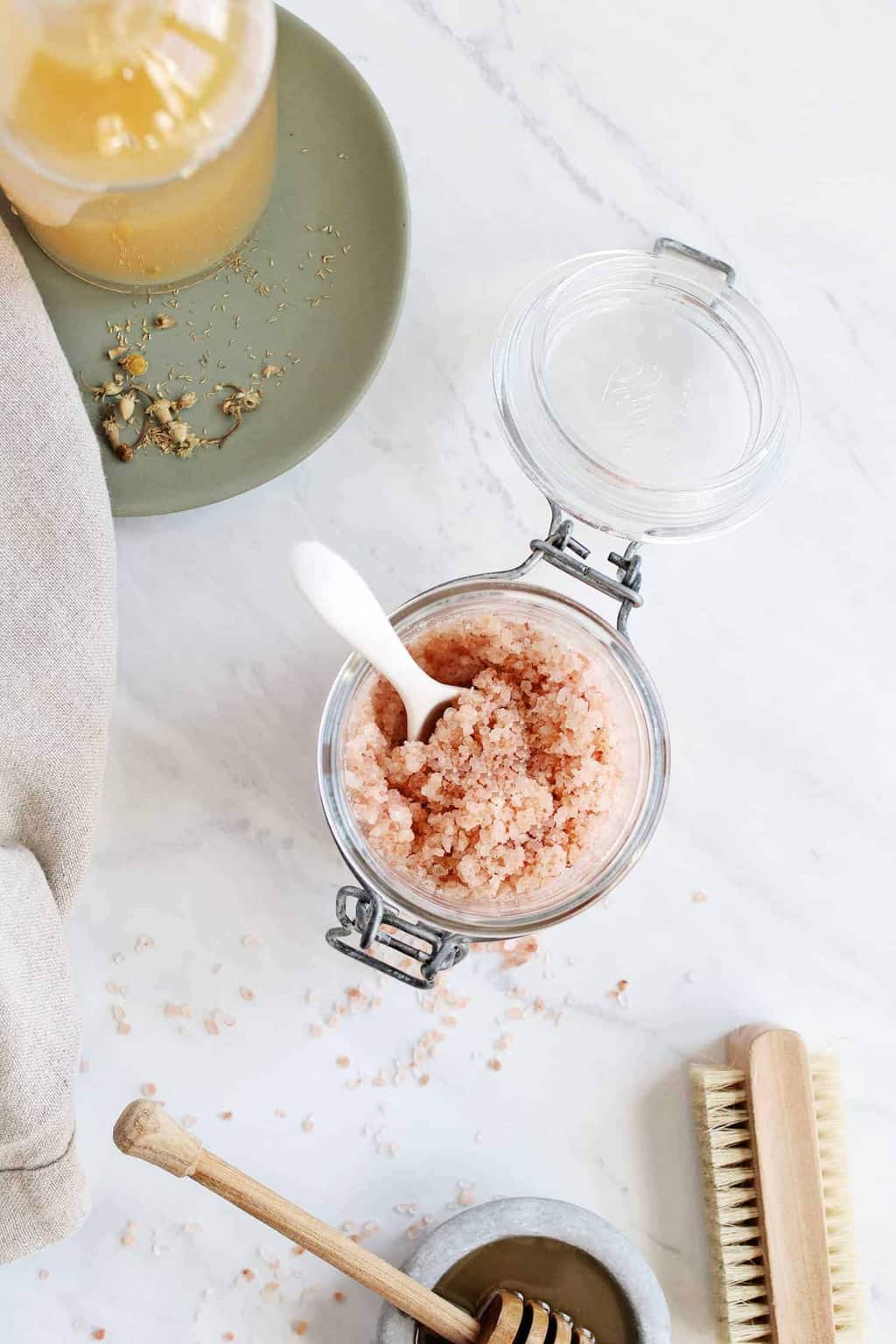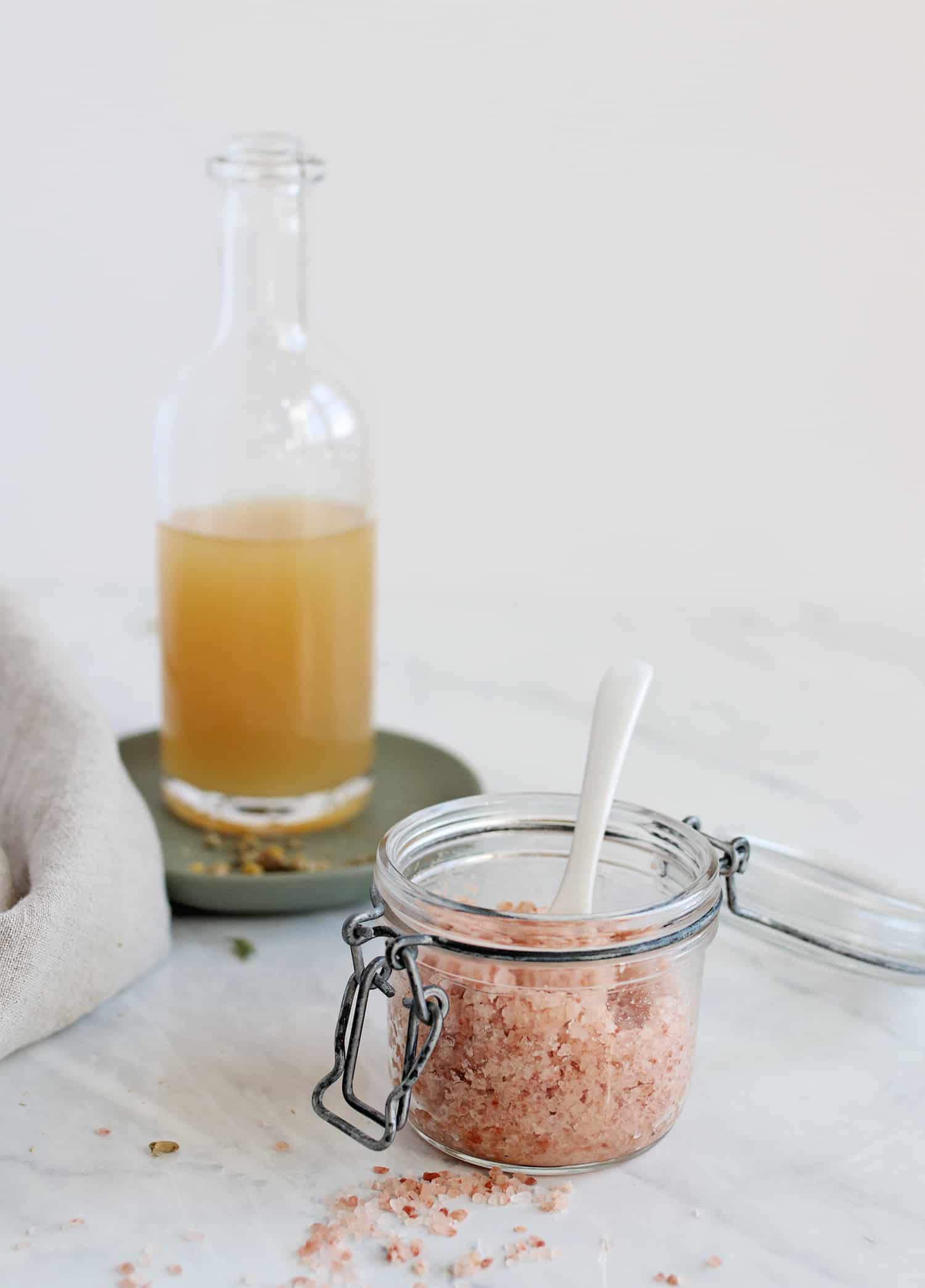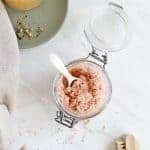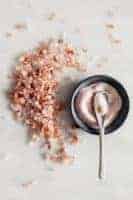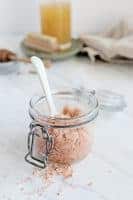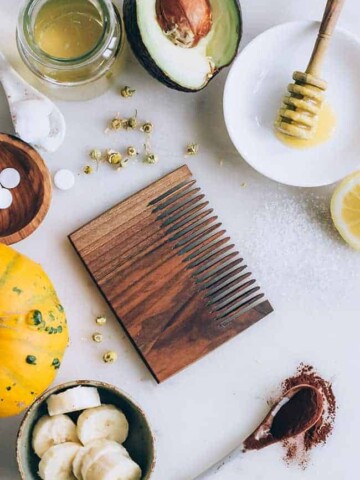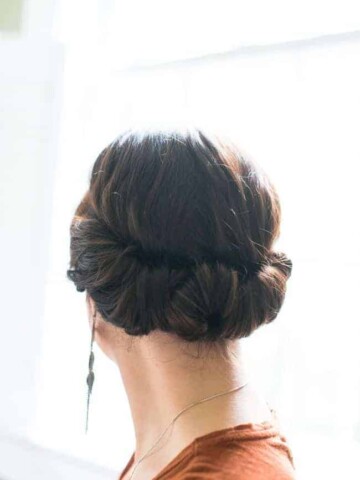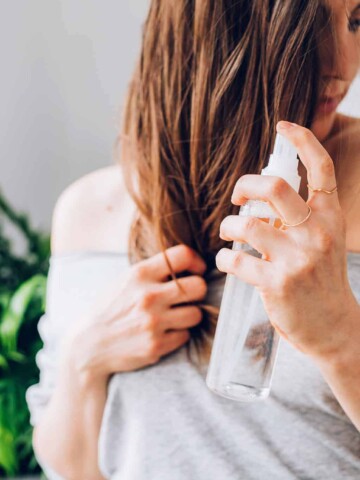While most of us think of detoxing as a great way to reset our bodies and maybe even lose a couple of pounds (and it totally is!), your internal body isn’t the only thing that needs an occasional cleanse. Your scalp is practically begging for a little TLC as well—and what better way to do that than with an apple cider vinegar scalp scrub.
Jump to:
Meet the Experts
Brendan Camp, M.D., a dermatologist at MDCS Dermatology
Marisa Garshick, M.D., a dermatologist at Medical Dermatology & Cosmetic Surgery (MDCS) in New York
Kerry E. Yates, trichologist and CEO of Colour Collective
Benefits of an Apple Cider Vinegar Scalp Scrub
In case you're unfamiliar, apple cider vinegar is a type of vinegar that comes from the juice of crushed apples. "With the help of microorganisms, the juice is fermented and converted to an acid," explains Brendan Camp, M.D., a dermatologist at MDCS Dermatology. "Apple cider vinegar contains acetic acid, which can be beneficial for the skin, acting as a chemical exfoliant."
Much like the pores in your skin, hair follicles can become clogged with oil, dirt, and product build-up, leaving you with lackluster strands of flat, limp hair. But using ACV can help detox and refresh your scalp while removing impurities that may cause dandruff, hair fall, and oily locks.
If you use commercial hair products, chances are your shampoo is loaded with parabens, sulfates, and other chemicals that may linger in your scalp and build up over time. I’m a total sucker for the shampoo and conditioner my hairdresser sells (ohh... that shine), but after a while, it feels like even my fave products just aren't cutting it.
My hair looks limp and lifeless, and I notice a little more grease than usual. That’s when I know it’s time for a detox.

Why Scrub Your Scalp?
This apple cider vinegar scalp scrub naturally sloughs off product build-up and removes dead skin cells that might be weighing your hair down. Scalp scrubs are so easy to make, and by getting rid of the impurities that can block hair follicles, you can help promote circulation, encourage hair growth, and get rid of stubborn bacteria.
Although the science supporting most ACV detox claims is limited, many of its properties are beneficial for both the skin and hair. We've used apple cider vinegar in everything from shampoo to tonics to hair rinses. When applied topically, apple cider vinegar may help:
Exfoliate skin
ACV is loaded with a natural alpha-hydroxy acid, malic acid, which may help to gently exfoliate the skin which can help reduce dead skin build up on the scalp, notes Marisa Garshick, M.D., a dermatologist at Medical Dermatology & Cosmetic Surgery (MDCS) in New York.
Balance skin pH
ACV has long been used to help balance skin pH, which, in turn, keeps the scalp functioning as it should, i.e., producing the right amount of oil and fighting dandruff-causing yeast overgrowth.
Clear clogged pores
The anti-inflammatory benefits of apple cider vinegar are very good when it comes to keeping things like redness and flakes at bay and helping to clear clogged pores.
And especially when combined with other clarifying ingredients, like pink Himalayan sea salt, coconut oil, and nourishing hair essential oils, a good old-fashioned detox scrub can do wonders for your hair.
Sea salt contains vitamins and minerals that help boost skin health and nourish hair, starting at the root. And coconut and essential oils replenish moisture that may get stripped away by the vinegar.
But your choice of ingredients isn’t limited to just the ones I use. Feel free to tweak your scrub by adding any of the following:
—ground herbs and botanicals, like rosemary, thyme, and flower petals
—lemon or lime zest
—ground ginger
—oatmeal
The exact ratio of ingredients isn't too important since it only sits on your scalp for a minute or two. Just play around with your recipe until you find one that works for you and your hair (or see below for 3 different recipes you can make, depending on your hair's needs.)
So if you’re ready to refresh your locks and show your scalp some TLC, here’s how to make your own ACV scrub.
[youtube https://www.youtube.com/watch?v=R5JPYWLi-s8]
ACV Scalp Scrub 3 Ways
Everyone's scalp is different. ACV is an excellent at-home ingredient to use to reduce product build-up or make hair less oily. It is also a good option for a natural remedy for dandruff.
Dr. Garshick recommends using ACV 1-2 times per week, but warns against any more than that frequency to minimize any potential irritation. Additionally, overuse can actually make the hair brittle, dry and can naturally lighten hair, notes Kerry E. Yates, trichologist and CEO of Colour Collective.
The consistency is quite fluid, mimicking water, the liquid viscosity can make it hard to apply and evenly saturate each strand. Plus the physical smell is a bit off-putting. The smell will dissipate when the hair is dry but it is not completely gone and can take upwards of 2 shampoos to completely dissipate.
Based on feedback from our readers, we found that the original recipe could be a little strong for some people, so we put together two additional detox scrubs that give you all the benefits without the tingle or greasy after-effects.
The Original Apple Cider Vinegar Scalp Scrub
—¼ cup Himalayan pink salt, lightly ground
—1 tablespoon apple cider vinegar
—1 tablespoon coconut oil, melted
—1 teaspoon Manuka honey (or raw honey)
—15 drops grapefruit essential oil or other oil of your choosing
Dry Scalp Scrub
—¼ cup sugar (sucanat or coconut sugar would be great for this)
—½ tablespoon apple cider vinegar
—½ tablespoon water
—1 tablespoon coconut oil melted
—1 teaspoon Manuka honey
—15 drops lavender essential oil or other essential oil for dry scalp
Squeaky Clean Scalp Scrub
—¼ cup Himalayan pink salt, lightly ground
—1 tablespoon apple cider vinegar
—1 tablespoon shampoo
—1 teaspoon baking soda
—½ tablespoon coconut oil, melted
—1 teaspoon Manuka honey
—15 drops grapefruit essential oil or other oil of your choosing
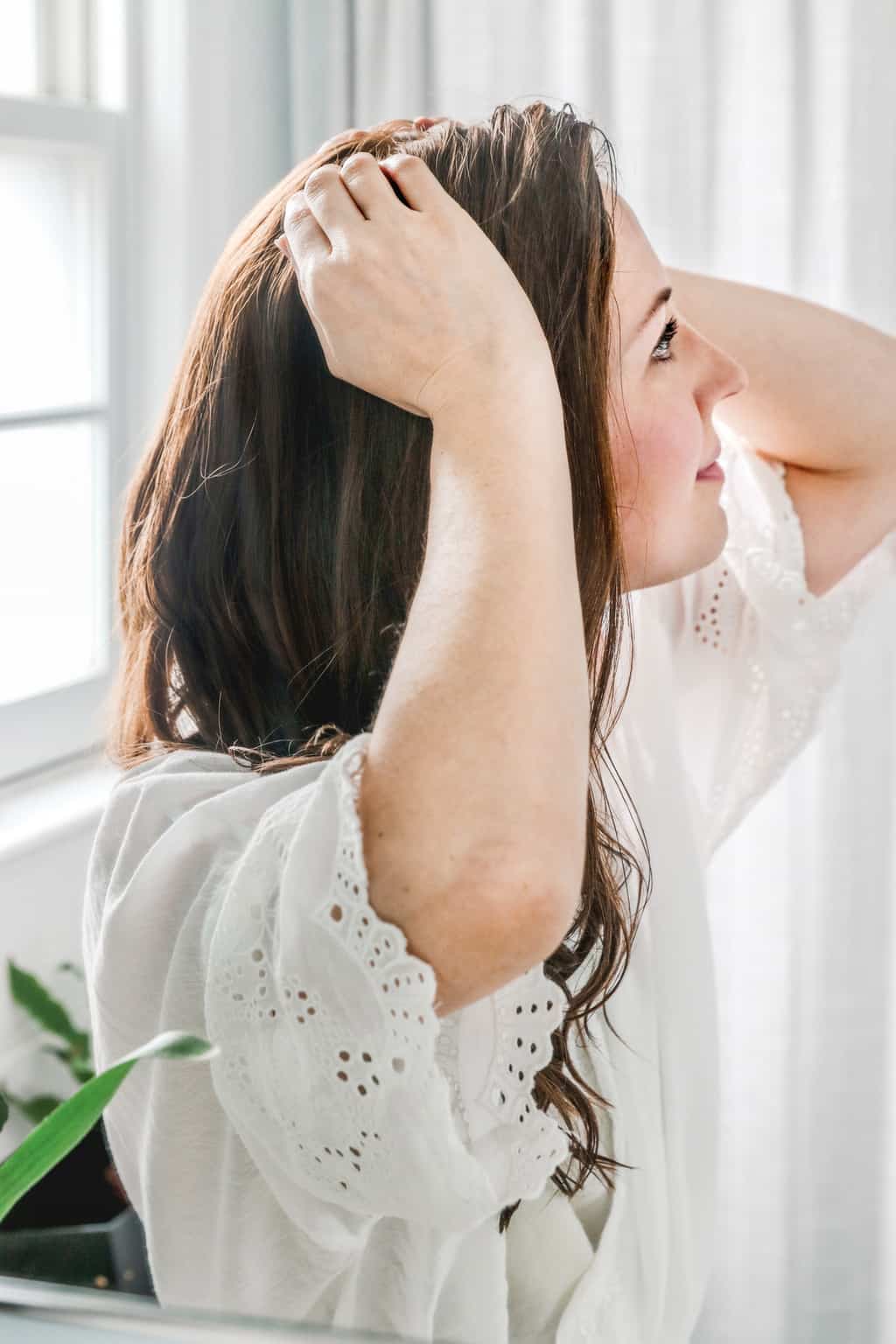
How to Use an Apple Cider Vinegar Scalp Scrub
1. Hop in the shower and lightly wet your hair and scalp. Squeeze out any excess water.
2. Using your fingertips, scoop one to two tablespoons of scrub from the jar, and rub it between your hands.
3. Starting at your hairline and working toward the back of the head, gently massage the scrub into your scalp. Don’t expect your scrub to foam up like shampoo. The coconut oil will melt some, making your scrub a little less solid, but since there’s no soap, it won’t get foamy.
4. Once you've reached the back of your head, work your way back toward the hairline.
5. If you have longer hair, try flipping your head over in the shower in order to reach the back of the head and the crown.
6. Let sit for a minute or two before rinsing thoroughly and following up with shampoo and conditioner. It doesn't hurt to shampoo a second time if you have fine or naturally oily hair.
Note: Apple cider vinegar is strong enough to cause burns, so it should always be diluted with water either before or just after applying it to the skin.
I usually apply a handful of scrub to my hair and then make sure to dilute the mixture with a little bit of water once it's on my scalp. Diluting also makes it less drying, so it's safer for naturally dry and/or color-treated hair,
Scalp Scrub FAQs
How often you need to exfoliate will depend on how much product you use and what you're using. Most people will only need to exfoliate about once a month. Dr. Garshick recommends not using ACV more than 1-2 times per week max, as overdoing it on the ACV can make hair brassy or upset the scalp’s pH balance.
Yes! Any honey will work, but raw honey is best because it has vitamins and minerals you won’t find in the processed stuff. It doesn’t have to be manuka honey.
Like the skin of the face, the skin on your scalp can be sensitive to certain ingredients. Apple cider vinegar is acidic and can make the skin tingle or even burn slightly.
If you run into this problem, take a handful of scrub and add about 2 tablespoons of water before applying to your scalp. The more you dilute the scrub, the less it will irritate your skin.
I do because I have naturally fine hair that looks better when it's squeaky clean. But you don’t have to. It really just depends on your hair and how it responds to leaving product in. You might find that shampooing your hair helps to get the salt out after you’re done scrubbing.
Salt and vinegar both tend to strip or change hair color, so either try it on a small patch or skip it altogether. To make it less harsh, you can always replace the salt with sugar and water down the ACV with 1–2 tablespoons of water.
I recommend storing it in the fridge and using it within a week.
Yep! You can use any oil you like.
Sure! You might miss out on a few of the minerals in sea salt, but it should still leave you with a clean scalp.
Of course. Try raw organic sugar instead.
Apple Cider Vinegar Scalp Scrub
Equipment
- Coffee grinder (optional)
- Small bowl
- Jar with lid
Materials
- ¼ cup Himalayan pink salt, lightly ground
- 1 tablespoon apple cider vinegar
- 1 tablespoon coconut oil, melted
- 1 teaspoon Manuka honey (or substitute regular honey)
- 15 drops grapefruit essential oil (or another oil of your choosing)
Instructions
- If you can only find coarse sea salt, grind about ⅓ cup salt in a clean coffee grinder until you have a semi-fine texture (a few coarse pieces are okay).
- Combine everything in a small bowl and stir. Transfer to an airtight container.
- To use, lightly wet your hair ,and gently scrub a tablespoon-sized amount into your scalp using your fingertips (don’t expect the scrub to foam like soap). Let it sit for 5–10 minutes before rinsing with warm water. Follow up with shampoo and conditioner as usual.
Video
Notes
- ¼ cup sugar (sucanat or coconut sugar would be great for this)
- ½ tablespoon apple cider vinegar
- ½ tablespoon water
- 1 tablespoon coconut oil, melted
- 1 teaspoon Manuka honey (or regular honey)
- 15 drops lavender essential oil (or another oil of your choosing)
- ¼ cup Himalayan pink salt, lightly ground
- 1 tablespoon apple cider vinegar
- 1 tablespoon shampoo
- 1 teaspoon baking soda
- ½ tablespoon coconut oil melted
- 1 teaspoon Manuka honey
- 15 drops grapefruit essential oil (or another oil of your choosing)
This post was medically reviewed by Dr. Jennifer Haley, a board-certified dermatologist with extensive experience in medical, cosmetic, and surgical dermatology. Learn more about Hello Glow’s medical review board here. As always, this is not personal medical advice, and we recommend that you talk with your doctor.


